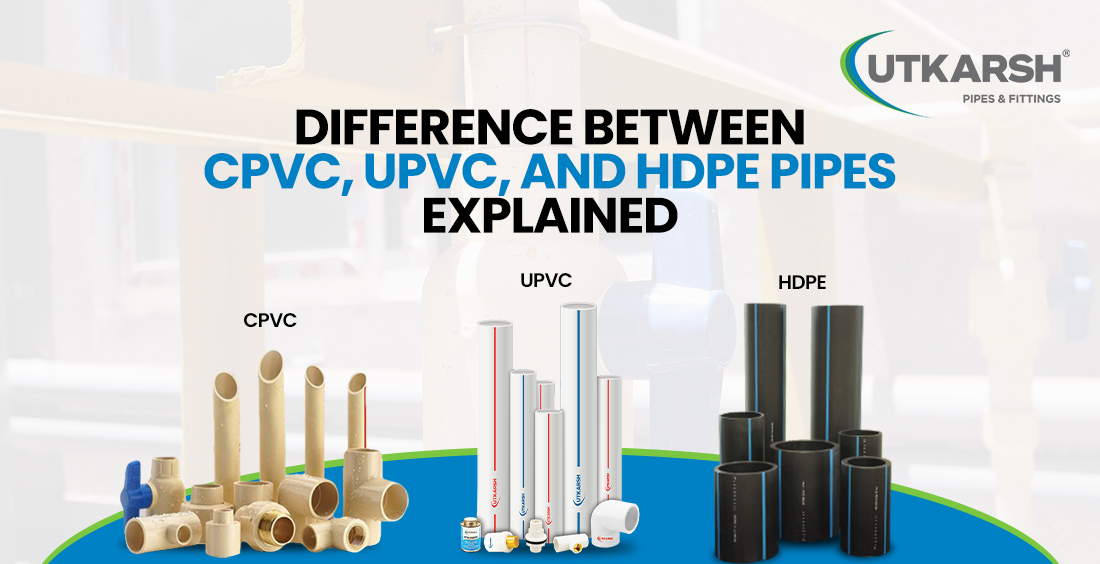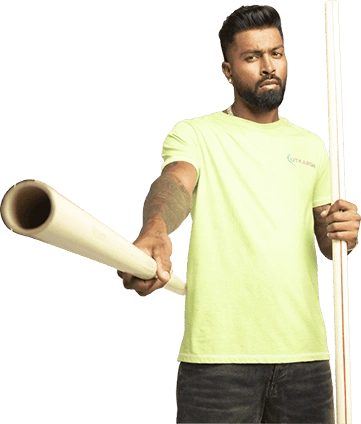Difference Between CPVC, UPVC, and HDPE Pipes Explained

Ever wonder what’s hidden behind your walls, carrying water to your faucet, or in your bathroom, managing waste? The unsung heroes of any building are its plumbing pipes. Choosing the right type is important for a long-lasting, efficient, and safe water flow. Today, plastic pipes are often the go-to choice, replacing older metal options. They are lighter, resist rust, are easier to install, and are generally kinder to your budget. But with names like CPVC, UPVC, and HDPE floating around, it can get confusing. Let’s break down the difference between these common types of plastic pipes for plumbing in simple terms.
Plastic pipes have become the preferred choice, and they are steadily replacing old-school metal pipes. CPVC, UPVC, and HDPE are now the most common terms preferred for any piping solutions.
Why Plastic Pipes Rule Modern Plumbing
Some of the best features why these plumbing pipes have become so popular
- No Rust: Unlike iron or steel, plastics don’t corrode, ensuring cleaner water and longer life.
- Light Weight: Makes them much easier to transport, handle, and install.
- Smooth Inner Surface: Their smooth inner wall means less friction, allowing water to flow freely and efficiently.
- Chemical Resistance: They handle common water treatment chemicals very well
- Cost-Effective: Generally more affordable than metal alternatives.
Understanding the Different Types of Plumbing Pipes
1. CPVC (Chlorinated Polyvinyl Chloride) Pipes
The main feature of CPVC pipes is to tolerate heat, which is a limitation in the case of PVC. The “C” stands for Chlorinated, which is significant to tolerate the heat. Therefore, it is suitable for both hot and cold domestic water uses.
Common Uses: Entire domestic hot and cold water supply system within buildings, industrial liquid handling.
Key Benefits:
- Heat Resistance: It can withstand temperatures up to 200 degrees Fahrenheit, ideal for a hot water supply.
- Corrosion Free: Does not rust easily like metal pipe also guarantees long-lasting performance.
2. UPVC (Unplasticized Polyvinyl Chloride) Pipes
It is also known as Rigid PVC. The ”U” means no plasticizers (softening chemicals) are added.
Key Features:
- Super Strong and Stiff: Even more rigid and durable than standard PVC. Excellent for structural pressure.
- Weather Suitable: High resistance to sunlight (UV rays) and weathering, making it ideal for outdoor use.
- Chemical Resistance: Handle corrosive elements exceptionally well.
Common Uses: Main underground cold water supply lines, especially where high pressure or external exposure is a factor, industrial piping, and waste systems.
3. HDPE (High-Density Polyethylene) Pipes
Known for their flexibility and toughness. Usually black with distinctive raised stripes.
Key Features:
- The Flexibility: Can bend or curve, making it great for navigating around obstacles or uneven terrain without needing many fittings.
- Leak-Proof Joints: Uses heat fusion to weld joints, creating seamless, incredibly strong, leak-proof connections.
- Impact Resistance: Tough and resistant to cracks, even in freezing conditions.
- Corrosion and Chemical Proof: Excellent resistance to a wider range of chemicals and abrasion.
Common Uses: Main underground water supply lines (municipal and rural), gas distribution, slurry and mining pipelines, agricultural irrigation, and marine outfalls. Less common inside the house for standard hot/cold supply compared to CPVC.
PVC vs. CPVC vs. UPVC vs HDPE: A Quick Comparison
How to Choose the Right Pipe
There is no single “best” pipe. The right choice depends entirely on your project:
- Temperature: CPVC is essential for indoors as it is suitable for both hot and cold water. UPVC, or HDPE, is suitable for cold water.
- Location: CPVC is recommended for water flow. For outdoor exposure to the sun, UPVC is an excellent choice. And for buried underground, HDPE, UPVC are strong contenders.
- Pressure: To resist high pressure, UPVC or HDPE are excellent choices. Standard household uses can be done with CPVC, which works well.
- Flexibility: HDPE shows the major advantage of flexibility. Toughness and rigidity can be found in CPVC and UPVC.
- Leak Proof: HDPE is the answer for leakproof and comfortable welded pipe connections.
Trust the Expert for Quality Flow:
Understanding these different factors empowers you to make informed decisions, whether you are a homeowner planning a renovation or a professional specifying materials. Using the right type of plastic pipes for plumbing ensures safety, efficiency, and longevity for your plumbing system.
When quality and reliability are non-negotiable, choosing a pipe from a reputable pipe manufacturer is an essential choice to make. At Utkarsh Pipes and Fittings, we take pride in manufacturing a wide range of high-performance CPVC, UPVC, and HDPE pipes designed to meet diverse needs and stringent quality standards. Utkarsh pipes use premium materials and advanced processes to deliver pipes you trust for every application-from the main supply lines to your kitchen sink.
Explore our range and find the perfect pipe solution for your next project. Over the last five decades, Utkarsh Pipes and Fittings has been a partner for reliable, efficient, and long-lasting plumbing systems in Kolkata.











